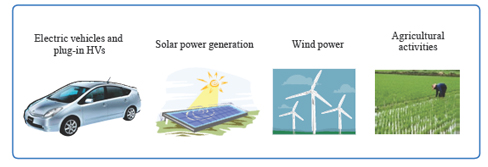Overview
Conventional mobility relies on automobiles driven by internal combustion engines, which are powered primarily by petroleum-based fuels. However, environmental constraints and resource constraints require the development of new mobility tools and systems.
In this laboratory, we research transportation tools and the systems to support them, with a focus on coexistence with human living spaces. Our scope extends beyond transportation systems themselves to also examine issues in agriculture and plant production in Japan as they relate to bio-energy.

Research topics
Names in parentheses () are students involved in the research
1. System Design of the Symbiosis Community Composed of City and Rural Areas Using the Biomass Energy Technology as the Core Element (Takashi Yamamoto)
Aims
This research investigates ways of realizing the symbiosis of the social community and the biomass recycle system and investigating their effects and problems as part of a larger exploration of the potential using bio-energy and creating new collaboration between urban and rural areas.
Major results
It is difficult to achieve profitability at current costs using biogas transformation technology on its own. The least onerous approach to recovering the investment within a period of 15 years would be an environmental tax of about 20 yen per resident per year.
2. High-Penetration Distributed Photovoltaic System Design (Toshiyuki Seto)
Aims
Techniques of power systems analysis are used to examine the suspension of photovoltaic systems due to rises in electricity grid voltage during the process of mass-market penetration of photovoltaic systems. The findings are then adjusted for the behavioral rules of multi-agent simulation to elucidate the impact of strength of government etc. incentives for this technology.
Major results
The faster the speed with which photovoltaic systems spreads, the larger the number of batteries required. (Battery waste occurs.) If the spread of photovoltaic systems is staggered over time and location, penetration will be achieved more quickly and with fewer batteries by working from locations close to substations outwards than by working from farther locations.
3. Study of Carbon Dioxide Reduction by Sharing Battery Set with Photovoltaic System (Emiko Tsuji)
Aims
Concurrent installation of batteries is one conceivable means of avoiding the suspension of generation due to higher grid voltages, one of the problems encountered in photovoltaic power generation. This research tries to identify reductions in battery volumes with shared use of batteries, based on home electric power consumption patterns elucidated from the living patterns of real-life homes.
Major results
We have found that even in systems that do not allow a reflux of generated power on the grid, the sharing of batteries can result in an increase of up to 4% in generated power. Equivalent effects are expected if the supply and demand balance is controlled in real-time without installing batteries into homes. (Development of smart grids)
4. A Study on Dissemination Process of Farming Experience-Farm using Multi-Agent Simulation (Takeshi Otsuka)
Aims
Farming experience farms are spreading, particularly in urban areas. This research uses interviews with operators to analyze the spread of farming experience farms and identify approaches for more efficient penetration.
Major results
Consumers express a high "satisfaction" with farming experience farms, but also indicate that they "quickly grow tired of them." For greater numbers to participate, first-time participants need to be given experiences that are "exciting and moving," rather than "not becoming bored" programs.
5. Design and Consideration of Plant Factory for Value Creation (Yasuhiro Matsuo)
Aims
Japanese agriculture must address a number of issues, including the lack of successors and questions of food security. Plant factories have received wide attention, and the aim of this research is to apply systematic design techniques to the design of plant factories that are valuable to customers.
Major results
Analysis using QFD, the Pugh Method and other techniques led to the concept of "solar light sources using the natural lighting systems of closed urban schools.” Surveys indicate that these systems better meet customer requirements than conventional plant factories.

Professor Shoichi Sasaki
Formerly Toyota Motor Corporation
Areas of expertise: Design of environmental and symbiotic systems, such as hybrid vehicles and other environment-friendly transportation systems
Books and Publications: "Permanent Magnet Motor Control Technology for Hybrid Vehicles,” Triceps,
one of the main characters .in a Japanese comic, ‘Wings of Prius’
Minister of Economy, Trade and Industry Award by Japan Institute of Invention and Innovation Award, Japan Institute of Invention and Innovation, 2004
2010 IEEE Daniel E. Noble Award

